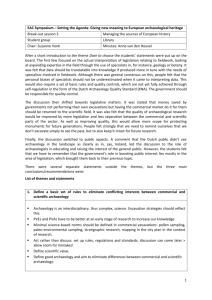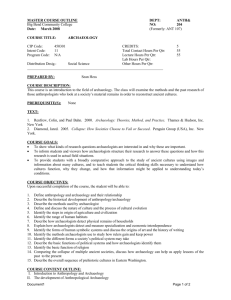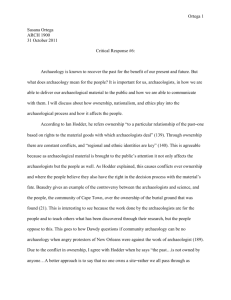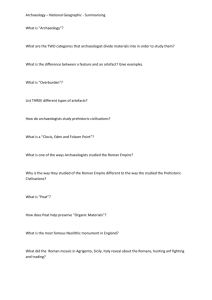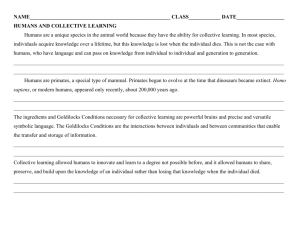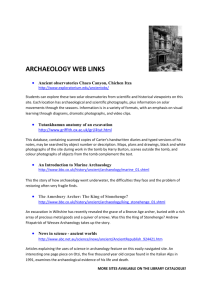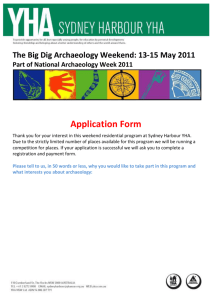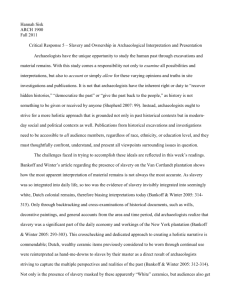Concept Paper 5
advertisement
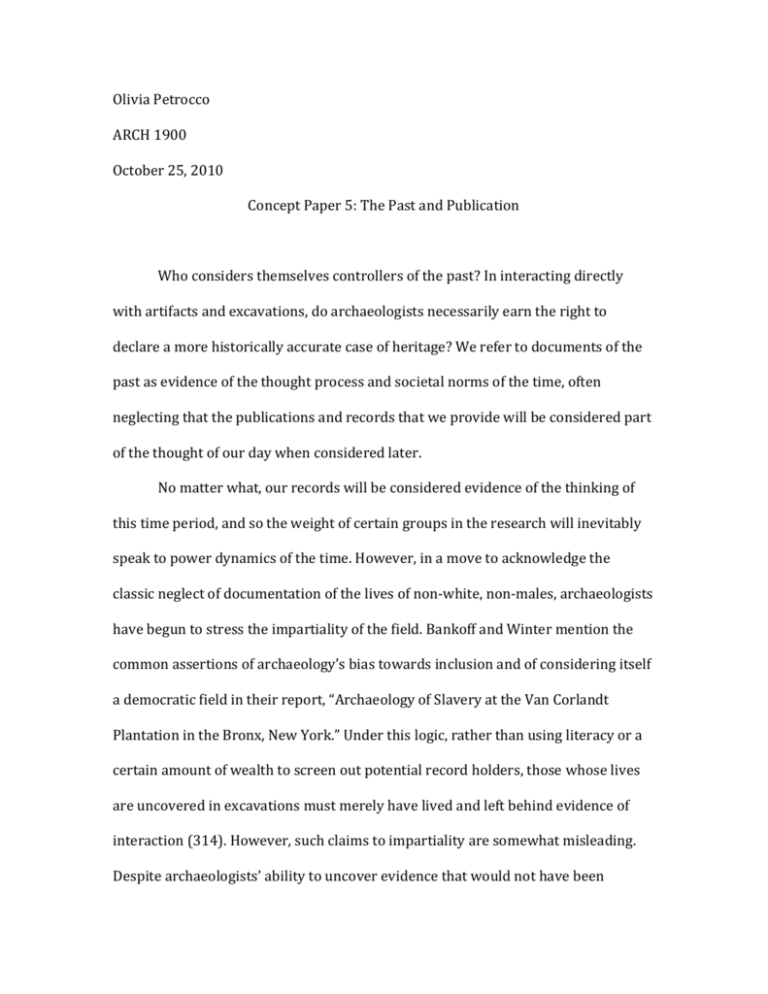
Olivia Petrocco ARCH 1900 October 25, 2010 Concept Paper 5: The Past and Publication Who considers themselves controllers of the past? In interacting directly with artifacts and excavations, do archaeologists necessarily earn the right to declare a more historically accurate case of heritage? We refer to documents of the past as evidence of the thought process and societal norms of the time, often neglecting that the publications and records that we provide will be considered part of the thought of our day when considered later. No matter what, our records will be considered evidence of the thinking of this time period, and so the weight of certain groups in the research will inevitably speak to power dynamics of the time. However, in a move to acknowledge the classic neglect of documentation of the lives of non-white, non-males, archaeologists have begun to stress the impartiality of the field. Bankoff and Winter mention the common assertions of archaeology’s bias towards inclusion and of considering itself a democratic field in their report, “Archaeology of Slavery at the Van Corlandt Plantation in the Bronx, New York.” Under this logic, rather than using literacy or a certain amount of wealth to screen out potential record holders, those whose lives are uncovered in excavations must merely have lived and left behind evidence of interaction (314). However, such claims to impartiality are somewhat misleading. Despite archaeologists’ ability to uncover evidence that would not have been classically found through written records, the elites who control the movements of the working or slave classes still greatly influence the material records left behind. As in the case of the Van Corlandt Plantation, the decision makers of the estate, that is to say the owners, are the ones whose decisions are reflected in the archaeological records. There is no material evidence of the slave population having ever existed on site (306). The servants at the Van Corlandt estate may have used the ceramic pieces that were discovered in excavations, but the plates found their way into the archaeological record when they were discarded by the family when deemed unworthy of moving to their new house (312). The people who controlled the land also controlled the manipulation of that land, and so have come to dominate the material record left behind. Despite considerations of heritage and respect for the slaves that also worked and lived on the estate, archaeology is limited to the material discoveries at a site. Given the unequal power dynamics in shaping the landscape and material remains left behind, archaeologists need to draw a fine distinction between acting as representative of the material record of a site, and the uncomfortable role of sole interpreter of the significance of that record. For example, though the material record of the Van Corlandt Plantation does not offer much insight into the lives and experiences of the slave population, the slave population does not cease to be relevant or important. Rather, as many linkages to the past as are possible should be maintained and promoted, in order to connect as many people as possible to the site. For the Van Corlandt Plantation, there is tension over the ethnic identity of the site which carries over from the ethnic tensions of surrounding areas (315). Though the archaeological record only provides strong ties for the owners of the house, it is the responsibility of the estate to promote awareness of all former residents, despite their ability to shape the material evidence of the site. The archaeological evidence, though scientific and quantitative, cannot be the end of the meaning of a site. Archaeologists, however, do have a responsibility to justify the cause of excavation. In the quest to excavate the Preswitch Street site in Cape Town, South Africa, archaeologists and developers ignored local knowledge and culture to exhume bodies from a known grave site, and then develop apartments on the site (Shepherd, 101). The excavations outraged the locals, begging the question: is archaeology always the best way to connect the past to the present? The local response is clearly negative. While in western society, and especially in the US, archaeology is widely regarded as a valuable endeavor, there are instances when the physical interruption of material remains is inappropriate. Even in the United States, the Native American Graves and Repatriation Act limits some excavation of Native American remains, as the culture values respect for their ancestors over the rediscovery of artifacts. When the disturbance of a space is contested, archaeologists need to engage with the audience in a way that allows them to understand the benefits of disruption in the name of archaeology. This dialogue was clearly lacking in Cape Town. In publications, archaeologists need to avoid framing their discoveries as the final say on the site. Though excavations attempt to be exhaustive, the constant innovation of technology means that more information will always be available in the future. As a result, the analysis of any site is never truly complete. The approach in publications need to acknowledge the external factors that affect the heritage, even informal heritages like the legacy of the haunted gravesite in Cape Town, and reiterate the limitations of archaeology to the study of physical and material remains. Works Cited: Bankoff, H. Arthur and F. Winter. 2005 The Archaeology of Slavery at the Van Cortlandt Plantation in the Bronx, New York. International Journal of Historical Archaeology, 9(4): 291-318 Shepherd, Nick. 2007 What does it mean 'To Give the Past Back to the People'? Archaeology and Ethics in the Postcolony. In Y. Hamalakis and P. Duke, eds. Archaeology and Capitalism, From Ethics to Politics. Left Coast Press; Walnut Creek, 99-114.

